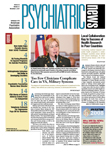Employees at a number of major U.S. corporations who were randomized to an enhanced depression treatment program that included a telephone outreach intervention experienced less-severe depression symptoms and increased work productivity and job retention compared with employees receiving usual care, according to a study in the September 26 Journal of the American Medical Association.
Employers are often reluctant to invest in depression screening and treatment programs due to fears that doing so would be expensive, according to the report. However, the results of a randomized, controlled trial led by principal investigator Philip Wang, M.D., showed that the increased work retention and number of hours worked by employees participating in the enhanced program translated into cost savings for employers.
Wang is director of the Division of Services and Intervention Research at the National Institute of Mental Health (NIMH).
“It will be helpful to start alerting employers to the fact that mental health benefits may actually be an investment opportunity,” Wang told Psychiatric News. “If they improve employees' mental health, they will get something back and improve their bottom line.”
Wang and his colleagues randomly recruited 604 employees from 16 major corporations covered by United Behavioral Health (UBH), a large managed behavioral health company, from January 2004 to February 2005 using a two-phase procedure.
Among the companies were an airline, insurance company, major bank, and public utility, and the participating workers represented a wide variety of occupations.
The employees at those companies first completed a health-risk appraisal, which included questions about various health problems, occupation, and sociodemographics.
Employees were also screened for depression with the Kessler-6 Psychological Depression Scale (K-6), and those who scored positive for depression were invited to participate in a telephone interview that assessed depression using the Quick Inventory of Depression Symptoms Self Report (QIDS-SR).
Employees who had a score indicating moderate depression were randomized to either an intervention group or a “usual care” group. Employees in the usual care group were informed that their responses indicated possible depression and advised to consult with a clinician as part of usual care.
Those in the intervention group had professionals described as “care managers” who via telephone contacts assessed them for treatment and facilitated treatment with medications and/or psychotherapy by encouraging patients and monitoring treatment adherence.
Those in the usual-care group did not receive the telephone case management contacts.
Those randomized to the intervention first completed the Patient Health Questionnaire–9, and care managers recommended to those with a significant level of depressive symptoms face-to-face, community-based psychotherapy and medication evaluation. The care managers provided treatment authorization and referral information.
Care managers recommended and facilitated treatment in the community for the intervention group and monitored the treatment closely. The care managers also maintained regular telephone contact with those in the intervention group who declined to seek treatment.
For those who had symptoms of depression after two months and still refused to seek treatment, care managers provided a structured course of cognitive-behavioral therapy by telephone. This included motivational enhancement exercises, help in focusing on rewarding activities, and identifying and challenging negative thoughts.
The care managers working with the intervention group were licensed, master's-level social workers and psychologists employed by UBH. A psychiatrist employed by UBH was available for consultation to clinicians, and some of the study authors, including Wang, provided about an hour of supervision a week to the care managers.
Wang measured several outcomes for participants in both groups, including work productivity (using the World Health Organization and Productivity Questionnaire) and depressive symptoms (using the QIDS-SR).
He found that after a year, the proportion of employees whose symptoms improved substantially (defined as a 50 percent improvement on the QIDS) was substantially higher in the intervention group (30.9 percent) than in the treatment-as-usual group (21.6 percent).
The proportion of employees experiencing recovery from depressive symptoms as indicated by a QIDS score of 5 or less was also significantly higher for the intervention group (26.2 percent) than the usual-care group (17.7 percent).
In addition, employees participating in the study's intervention arm worked an average of two more hours a week than those in the usual-care group.
Wang noted that the monetary value of working two more hours a week translated to about $1,800 per employee annually, and that the cost of similar interventions would range from about $100 to $400 per employee a year,“ so there is definitely a cost benefit,” he said, adding that employers who implemented such interventions would “experience a positive return on investment from outreach and enhanced treatment of depressed workers.”
He said further research will investigate the durability of the gains made by employees in terms of reduced depression and increased workplace productivity.
The study was funded by NIMH and the Robert Wood Johnson Foundation.
An abstract of “Telephone Screening, Outreach, and Care Management for Depressed Workers and Impact on Clinical and Work Productivity Outcomes” is posted at<jama.ama-assn.org/cgi/content/abstract/298/12/1401>.▪
